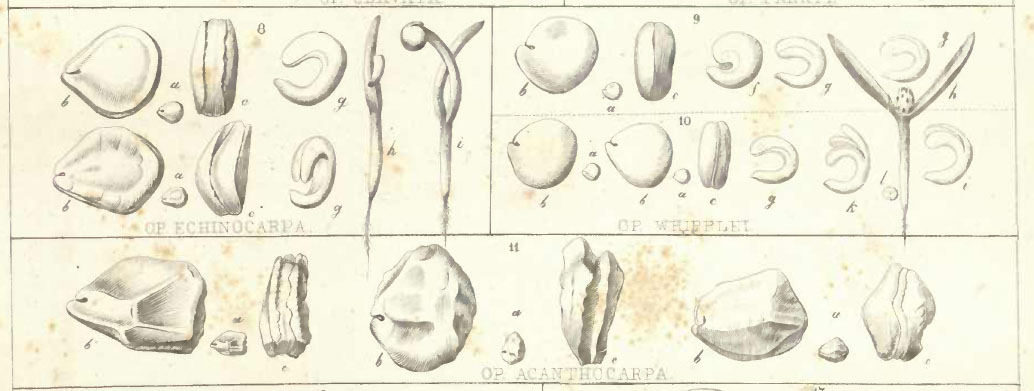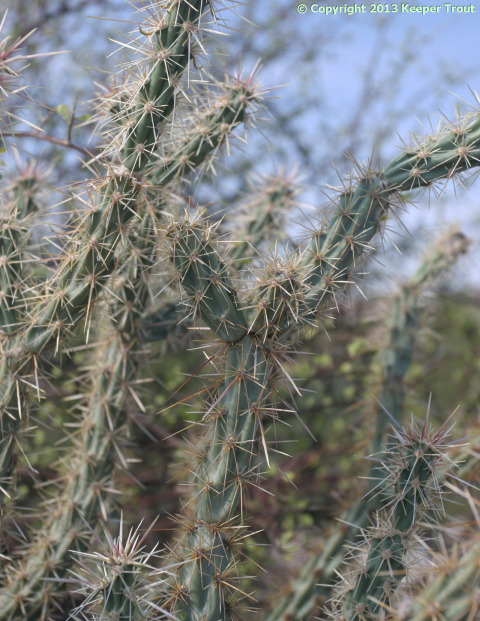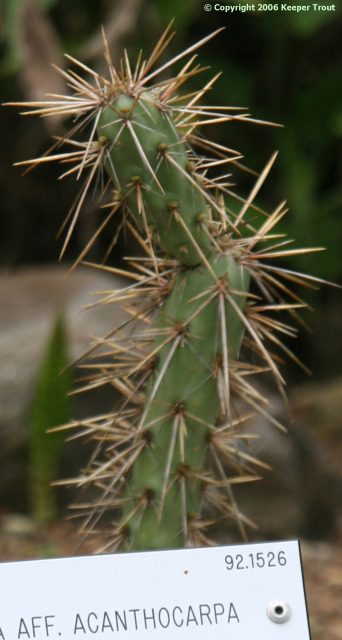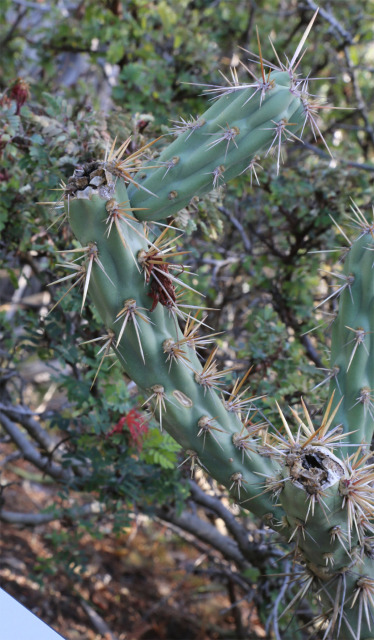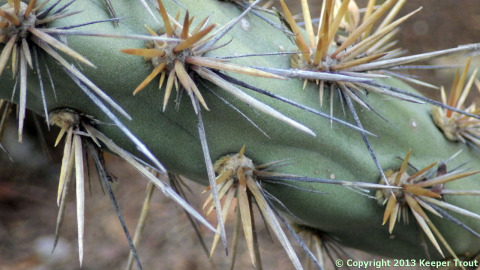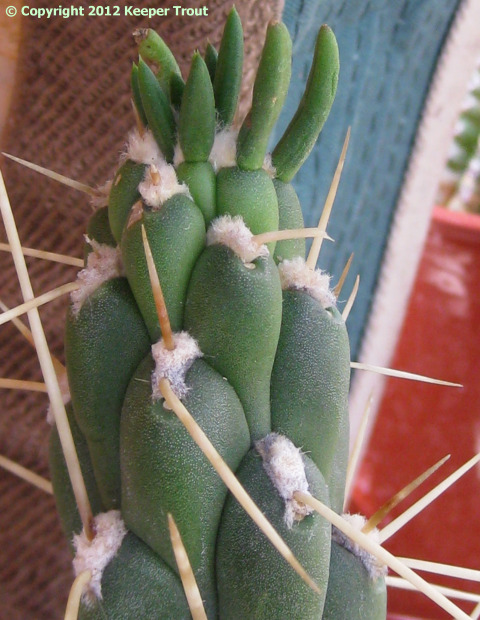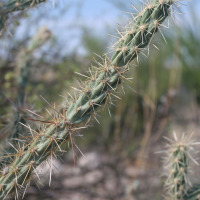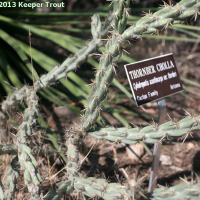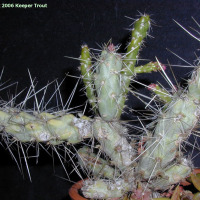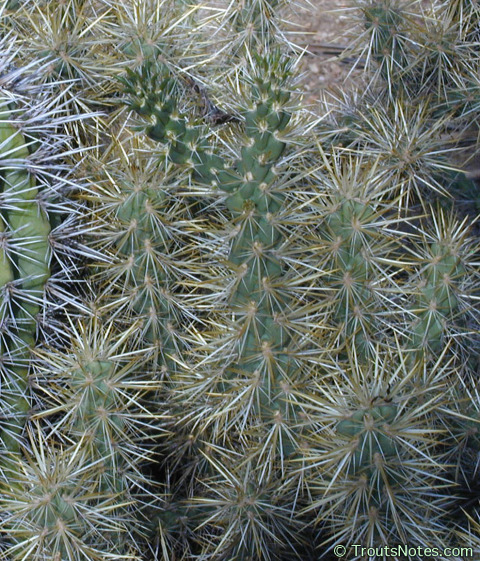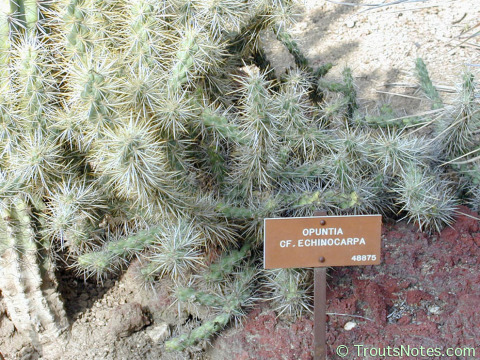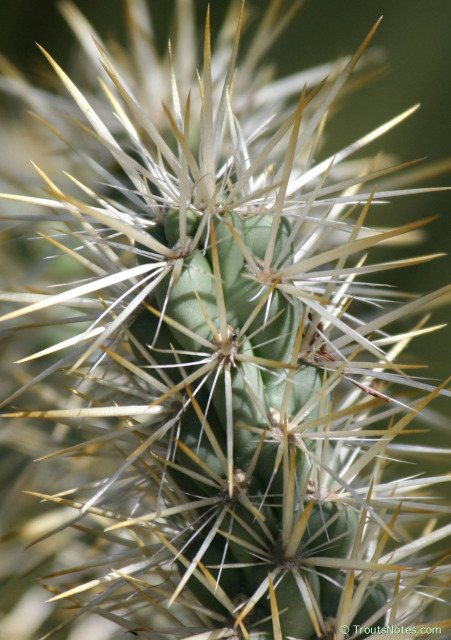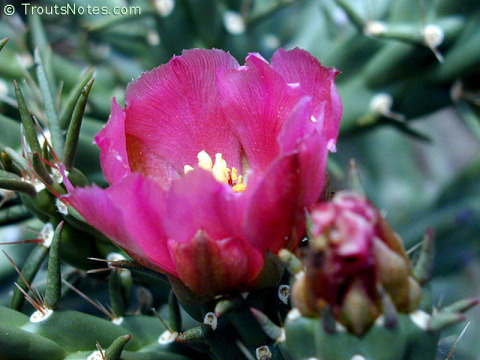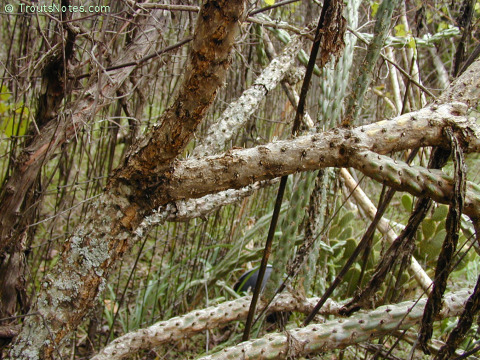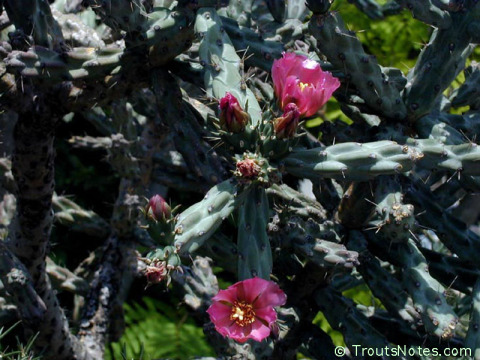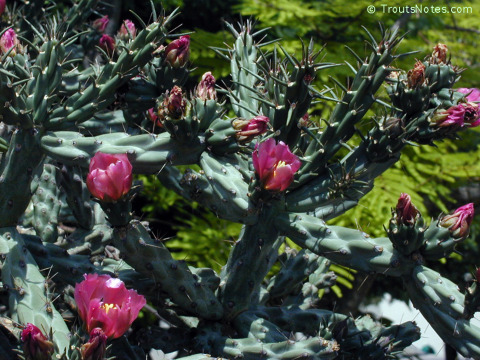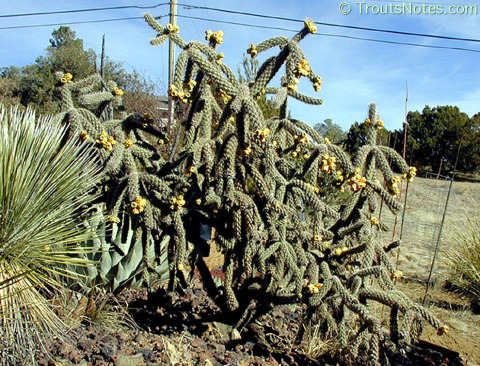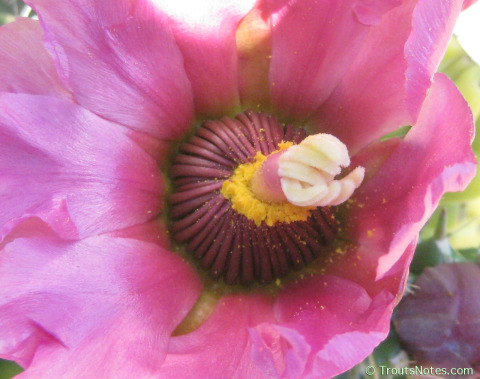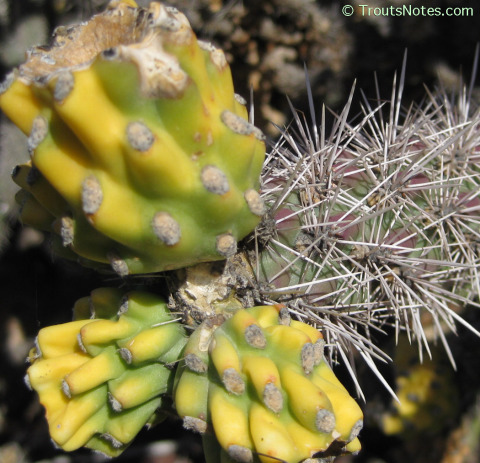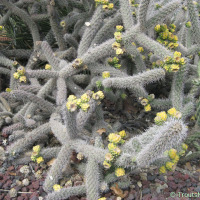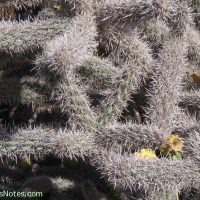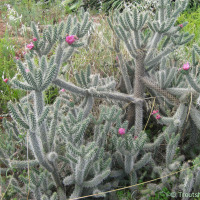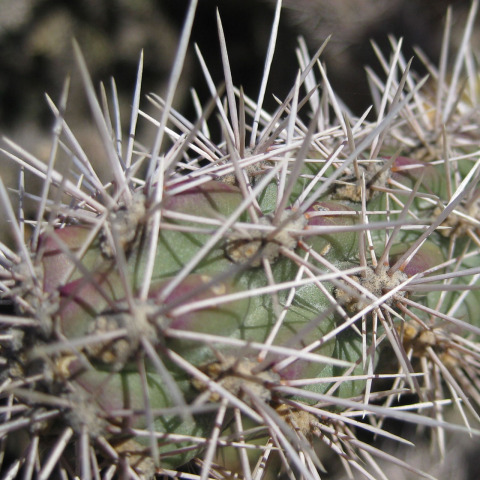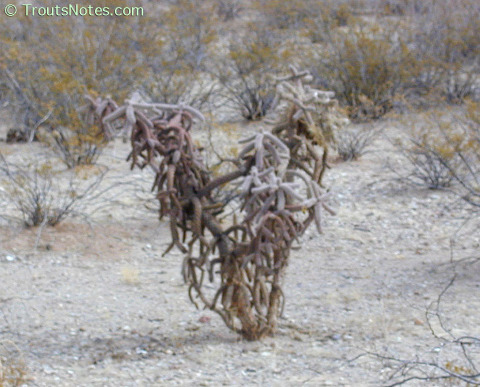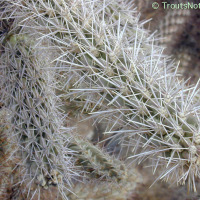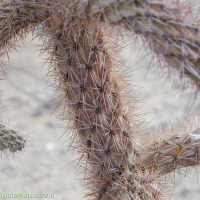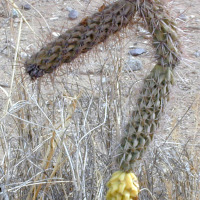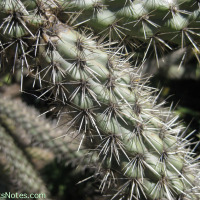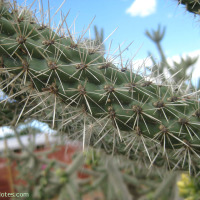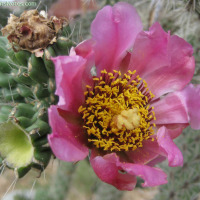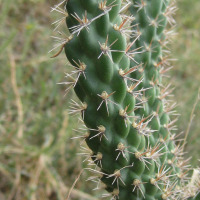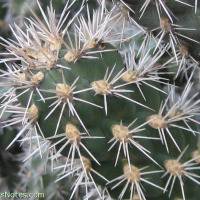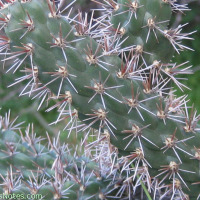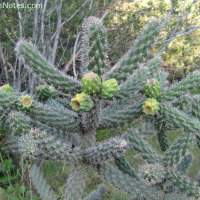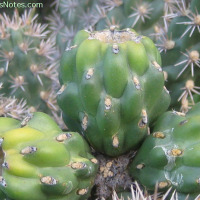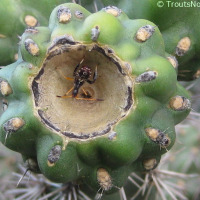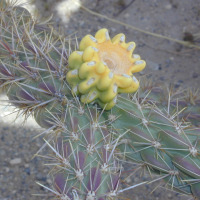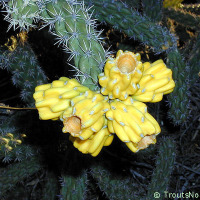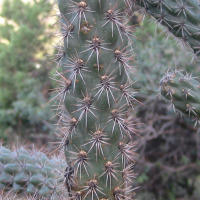Cylindropuntia acanthocarpa (Engelmann & Bigelow) Knuth
Georg Engelmann & Jacob Bigelow (1856) Description of the Cactaceae, 4 (5): 51- 52, 56, as Opuntia acanthocarpa.
F.M. Knuth (1936) Kaktus-ABC 124 [with C. Backeburg] as Cylindropuntia acanthocarpa.
Mescaline is present in trace amounts.
Common name: “Buckhorn cholla”, “Major cholla”.
Distribution: Arizona, California, Nevada and Utah. Also in Sonora, Mexico. Entry #212 in Piazzetti 1985
Etymology: “akanthos” means spines or thorns.
“caule arborescente erecto reticulato-lignoso, ramis adscendentibus divaricatis; articulis cylindricis tuberculatis pallide virescentibus; tuberculis oblongolinearibus pulvillis ovato-orbiculatis breviter tomentosis vix setosis, aculeis numerosis s. plurimis (8–25) stramineo-vaginatis undique porrectis, stellatis; bacca subglobosa late umbilicata tuberculata; pulvillis 12-15 tomentosis parce setosis aculeolis validis 8–10 munitis; seminibus magnis multangulis late commissuratis. (Plate XVIII, fig. 1-3 & XXIV fig. 11).”
“Stout, stem 5–6 feet high, wood forming a hollow reticulated tube, solid at base; branches few, never verticillate, separating at acute angles; joints 4–6 inches long, 1 inch in diameter, tubercles 9–10 lines long; pulvilli in some with one central and 6 or 8 exterior spines, in others with 3–7 interior and 10–20 exterior stellately radiating spines. Central spines 1–1¼ inch, exterior 4–10 lines long, with a yellowish or brownish sheath. Fruit 1 inch long with a large but not deep umbilicus, and 12–15 rather shallow tubercles; spines of fruit stout, 3–6 lines long, stouter and more crowded toward the top of the fruit. Seeds unlike any other of our Opuntiae, 2½–3 lines in diameter, with rather broad commissure, often spongy on the margin, and on the sides with many even or concave faces separated by sharp ridges.” p. 51, Engelmann & Bigelow 1856.
[“lines” = 0.1″]
Description:
Normally a sprawling densely spined cholla but it gets taller at higher elevations. Grows as very heavily branched shrubs from one to 5 feet. Lower growing plants are often confused with O. echinocarpa which has different flowers and tubercles. It has a wide range through the southwest and exists in a number of different varieties. Most are fairly densely spined with fine, usually dark brown, spines (lighter colored spines exist in some varieties) covered with straw colored sheaths and numerous glochids.
Flower color and size varies between varieties. Most range from yellow to brown but other colors including red, burnt orange and green are known. Flower buds are used as food by native people after spines are removed by steaming.
Fruit are variable in color and often densely spined.
See W. Hubert Earle 1980 and Lyman Benson 1982 for more information.
Both are excellent sources of detailed descriptions and pictures.
Earle has color photos of Opuntia flowers for all of the mescaline containing Opuntia species listed here.
Reported analysis:
Mescaline present at 0.01% (tlc, ms-ms) (dry weight) (To put that in perspective: 0.01% is 10 mg per 100 gm dry weight.)
3,4-Dimethoxyphenethylamine present at 0.01% (tlc, ms-ms) (dry weight)
3,5-Dimethoxy-4-hydroxyphenethylamine not detected with tlc but tandem mass spectrometry indicated it to be present at levels of less than 0.01% (dry weight)
Ma et al. 1986
- Cylindropuntia acanthocarpa thornberi
- Cylindropuntia acanthocarpa thornberi
- Cylindropuntia acanthocarpa
Cylindropuntia echinocarpa (Engelmann & Bigelow) F.M. Knuth
Georg Engelmann & Jacob Bigelow (1856) Description of the Cactaceae, 4 (5): 49-50, as Opuntia echinocarpa.
F.M. Knuth (1936) Kaktus-ABC, 124 [with Backeburg] as Cylindropuntia echinocarpa.
Mescaline is present in trace amounts.
Common name: “Wiggins’ cholla“, “Silver cholla”, “Golden cholla”
Distribution & occurrence: Occurs on slopes and flats in Arizona, Utah, Nevada and California.
“caule reticulato-lignoso, erectiusculo, ramis numerosis patentissimis subinde pene decumbentibus, articulis ovatis basi clavatis, tuberculis ovatis prominentibus confertis; setis paucis stramineis ; aculeis albidis stramineo s. albido-vaginatis, majoribus sub-4 cruciatis, ceteris, minoribus 8-16 undique radiantibus ; floris flavi (?) ovario pulvilIis 30-40 villosis subaculeolatisque confertis stipato, sepalis sub-13, exterioribus ovatis acutis ; interioribus obovatis mucronatis, petal is sub·8 obovatis obtusls s. subemarginatis denticulatis, stigmatibus 6 ; bacca globoso-depressa s. hemispherica, late profundeque umbilicata pulvillis sub-40 aculeolos vaginatos elongatos 8-12 gerentibus dense stipata, floris rudimento subpersistente coronata; seminibus subregularibus s. angulatis, crassis, late commissuratis, cotyledonibus parallelis. (Plate XVIII. fig. 5-10 XXIV fig 7.)
In the Colorado valley, near the mouth of Williams’ river. Mr. Schott found a stouter form further south. The more northern plant forms a low shrub 6-18 inches high, spreading, and often partially prostrate ; the cylindric tubular wood is reticulated with short meshes. Joints 1-2½ inches long, less than 1 inch thick, tubercles not more than 4 or 5 lines long ; bristles few and rather coarse; spines 12-20 ; the 4 larger ones are somewhat central, 9-12 lines long; the others radiating from 4-9 lines long ; the smaller ones, as in all these Opuntiae, hardly vaginate. Flower described from a withered specimen found attached to a fruit, to which it somewhat adhered, but perhaps held more by the long intricate spines than by an organic attachment. Flower 1½-1¾ inches in diameter, apparently yellow, which is uncommon among the Cylindric Opuntiae; petals about 9 lines long and three broad, stigmata about 2 lines long. The fruit is very peculiar, and with the seed, characterizes this species well. The wide umbilicus on the shallow fruit gives it the appearance of a saucer, and the seeds find their place more around the edge of the umbilicus than in the body of the fruit. Spines on fruit from 4-10 lines long. Seed 2 lines or more in diameter, with a broader commissure than any of the allied species, cotyledons always, in the specimens examined regularly accumbent or parallel; the only species, so far) where this regularly is the case; albumen unusually large.” pp 49-50, Engelmann & Bigelow 1856a.
“c. : erectiuscula ; ramis numerosis patentissimis ; articulis ovatis basi clavatis ; tuberculis ovatis confertis ; aculeis majoribus sub-4 albidis stramineo-vaginatis, 8-16 minoribus undique radiantibus ; flore flavo (?) ; bacca globosa depressa seu hemisphaerica late profundeque umbilicata pulvillis sub-40 aculeatissimis stipata ; semlnibus late commissuratis.
Var. β. MAJOR : elatior ; articulis elongatis ; aculeis longioribus laxius vaginatis paucioribus ; baccis globosis pulvillos pauciores (25) gerentibus.
In the valley of the Lower Colorado ; β. in Sonora. — Var. α. is a low shrub, 6-18 inches high ; joints 1-2 1/2 inches long ; tubercles 4- 5 lines long ; spines not over an inch in length. Flower apparently yellow, about 1½ inches in diameter and somewhat persistent on the fruit. Fruit very shallow, saucer-shaped, with few large seeds.
Var. β. is 4 or 5 feet high ; joints 8-10 inches long ; interior spines 1 – 1¾ inches long. Fruit globose or even ovate, with 25 pulvilli. Seeds the same in both.” pp 305-306, Engelmann & Bigelow 1856b.
Low growing densely branched plants with a distinct silver color. Grows 2 to 4-1/2 feet tall with a short woody trunk. Very dense spines are bright yellow when young but turn brownish or grey with age.
Flowers in May. Flowers are yellowish with a reddish streak on the edge of the petal.
Fruit are green turning tan.
W. Hubert Earle 1980 and Lyman Benson 1982 [Schuster 1990 also has picture.]
Reported analysis:
tlc indicated less than 0.01% mescaline by dry wt. while tandem ms estimated 0.01% by dry wt.
tlc indicated less than 0.01% 3,4-Dimethoxyphenethylamine by dry weight while tandem ms estimated 0.01% by dry weight.
3,5-Dimethoxy-4-hydroxyphenethylamine was not detected by tlc but tandem ms estimated its presence at 0.01% by dry weight.
Ma et al. 1986
Cylindropuntia imbricata (Haworth) F.M. Knuth
Adrian Hardy Haworth (1821) Revisiones Plantarum Succulentarum, 70, as Cereus imbricatus.
F.M. Knuth (1936) Kaktus-ABC, 125 [with Backeburg], as Cylindropuntia imbricata.
Now: Cylindropuntia imbricata (Haworth) F.M.Knuth var. argentea (M.Anthony) Backeberg.
Mescaline was detected.
Common names: USA “Cane cholla” “Cholla”; Mexico: “Coyonostli” [Safford 1908]
Etymology: Name means imbricated or lapping over.
Distribution & occurrence: Can be found growing up to 6,00 feet of elevation in eastern Cochise Co. Arizona. Widely distributed in New Mexico, Kansas, Texas, Oklahoma and south into Central Mexico. W. Hubert Earle 1980
“C. (imbricated) erectus teretiuscuIus non angulatus superficie porcis sublobulaeformibus varie subimbricatim tessellatis.
HABATAT. …
INTROD. a Dom. Loddiges 1820, sub hoc nomine.
St. ♄.
Species praesingularis distinctissima: at recte non examinavi. Affinis C. cylindrico, at robustior : sed forte cum illo genus proprium.” page 70, Haworth 1821.
Skeletons of stems (i.e. the woody vascular bundle) are “used for making ornamental furniture, napkin rings, picture frames, lamp stands and walking sticks.” Cuttings are also planted as hedges. p. 108 in Maxwell 1968.
A shrubby sometimes small tree-like cholla with a distinct short woody trunk. It has joints from 5 to 12 inches long which are 3/4 to and 1-1/2” in diameter, and grows from 6 to 10 feet tall. The joints are strongly tubercled and the tubercles are usually slightly flattened laterally to the stem. Numerous thin spines 3/4 to 1-1/4 inch long. Spines have a tan sheath initially which lasts until spring.
Flowers are magenta, borne terminally in clusters and are 2-3/4 inches in diameter. [Ed.: A rare white-flowering form from Cañon City, Colorado is sometimes available.]
Fruit are yellow and an inch to an inch and a half long. They bear few grey seeds.
This is a common desert plant, and also frequent in west central prairie grasslands. It is also widely cultivated as a xeriphytic landscaping specimen.
Type locality is not known; it was introduced into England in 1820
W. Hubert Earle 1980
[It is not infrequent to find it said or thought that the flowers on these plants are yellow. Generally, the source of the confusion is a source that has only seen them from a distance and mistaken the persistent yellow fruit for flowers. The white flowered saguaro cactus is the recipient of a similar error due to its red and splitting fruit.]
Schuster 1990: See page 146 for in habitat photo of Opuntia imbricata; next to Opuntia basilaris.
Reported to contain:
Tyramine (tlc, ms),
3-Methoxytyramine (tlc, ms),
Mescaline (tlc, ms)
3,4-Dimethoxy-β-phenethylamine (tlc, ms)
Mata & McLaughlin 1982 citing Meyer et al. 1980
Meyer et al. 1980 detected mescaline and the three other alkaloids using co-tlc in 5 solvent systems, and confirmed this with MS, but for some unexplained reason there was no apparent attempt at quantification. Normally McLaughlin’s research teams LOVE determining the most minute trace amounts; no matter how insignificant.
An additional unidentified alkaloid was observed with tlc.
This is a prolific and abundant species (some say a weedy pest) and, as such, should be examined more closely.
Cylindropuntia spinosior (Engelmann) Toumey
James William Toumey (1898) The Botanical Gazette, 25: 119 as Opuntia spinosior.
Frederik Marcus Knuth (1936) Kaktus-ABC, 126 [with Backeburg], as Cylindropuntia spinosior.
Originally Opuntia whipplei Engelmann & J.M.Bigelow var. spinosior Engelmann (1856) Proc. Amer. Acad. Arts, 3: 307.
Mescaline is present in trace amounts.
Common name: “Cane Cholla”
Etymology: from the Latin indicating a superior grade of “spiny”.
Distribution & occurrence: Occurs in eastern Arizona, western New Mexico and into northern Mexico.
- SRSU, Alpine, Texas
- SRSU, Alpine, Texas
- Cactus Country, VIC
This is a shrubby, often tree like species to 6 or 7 feet tall, covered with short, whitish spines and yellowish-white glochids. They tend to branch at right angles to the stems and have a short woody trunk up to 5 cm in diameter.
Brilliant flowers appear in May; purple or red but rarely yellowish or white. They are often 2 inches in diameter.
Fruits are yellow when ripe, almost spherical to egg-shaped with pronounced tubercles and deep pits on the top; seeds ~ 4 mm. in diameter, tan and few in number.
Earle 1980 & Benson 1982 & Weniger 1984
Olmos 1977 also features a color photograph of a specimen with flower on page 62.
These are rather hardy plants in the southern United States. Widely hated for their wicked barbed spines and widely loved for their ease of cultivation, striking appearance and beauty of flowers.
Reported analysis:
Mescaline was detected to be present by MIKES (Mass-analyzed, ion kinetic energy spectra) No concentrations were indicated. Kruger et al. 1977
(They used a “small portion” of the extract obtained from 1 gram of freeze dried cactus.)
Cuttings taken from the plants allowed the isolation of 0.00004% mescaline. [40 μg per 100 grams of dry plant.]
Identity was determined by tlc, mp, ir and ms.
Tyramine (0.0018%) was also recovered. (Identified by tlc, mp, ir and ms)
As well as 3-Methoxytyramine at 0.0011% (Identified by tlc, mp, ir, ms) and 3,4-Dimethoxyphenethylamine in quantities too small to isolate satisfactorily (identified by tlc and ms).
They were only able to get satisfactory separation from mescaline during tlc with Ethyl acetate-Methanol-58% Ammonium hydroxide (17:2:1). [Other workers have reported inadequate separation when using this solvent system; see comments under DMPEA in The Cactus Alkaloids for details]
[Plants were chopped into small pieces before being frozen and freeze dried.]
They extracted 3.150 kg. by defatting with petroleum ether, basifying the marc, and moistened, macerated and extracted by percolation with 30 liters of chloroform. After the solvents were removed, the syrup was separated into phenolic and non-phenolic fractions by use of Amberlite IRA-401S resin. Plant said to have been dealt with as per an earlier paper. [See more comments under Trichocereus peruvianus in San Pedro.]
By use of preparative tlc with Diethyl ether-Methanol-58% Ammonium hydroxide (17:2:1) and subsequent recrystallizations, they recovered 1.2 mg. of mescaline.
Visualized with fluorescamine and tetrazotized benzidine.
Pardanani et al. (1978) Lloydia, 41 (3): 287-288
-
southeastern Arizona
- southeastern Arizona
- southeastern Arizona
Those last four images were wild, this next image set is cultivated:
- Cactus Country
- Cactus Country
- Cactus Country
Initially I thought this last set was Cylindropuntia spinosior but after spending adequate time examining the fruit and counting their areoles determined it is an intermediate between C. spinosior and C. imbricata that occurs naturally in Grant County, NM.

